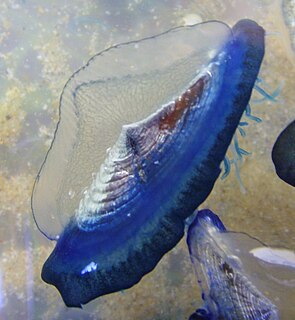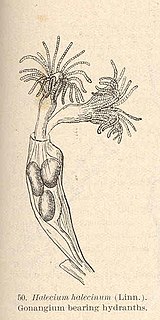
Hydrozoa are a taxonomic class of individually very small, predatory animals, some solitary and some colonial, most living in salt water. The colonies of the colonial species can be large, and in some cases the specialized individual animals cannot survive outside the colony. A few genera within this class live in fresh water. Hydrozoans are related to jellyfish and corals and belong to the phylum Cnidaria.

Velella is a monospecific genus of hydrozoa in the Porpitidae family. Its only known species is Velella velella, a cosmopolitan free-floating hydrozoan that lives on the surface of the open ocean. It is commonly known by the names sea raft, by-the-wind sailor, purple sail, little sail, or simply Velella.

Turritopsis dohrnii, also known as the immortal jellyfish, is a species of small, biologically immortal jellyfish found worldwide in temperate to tropic waters. It is one of the few known cases of animals capable of reverting completely to a sexually immature, colonial stage after having reached sexual maturity as a solitary individual. Others include the jellyfish Laodicea undulata and species of the genus Aurelia.

Hydractinia echinata is a colonial marine hydroid which is often found growing on dead, hermit-crabbed shells of marine gastropod species. This hydroid species is also commonly known as snail fur, a name which refers to the furry appearance that the hydroids give to a shell.
Bougainvilliidae is a family of marine hydroids in the class Hydrozoa. Members of the family are found worldwide. There are sixteen accepted genera and about ninety-three species.

Bougainvillia muscus is a marine invertebrate, a species of hydroid in the suborder Anthomedusae.

Tubularia indivisa, or oaten pipes hydroid, is a species of large hydroid native to the northeastern Atlantic Ocean, the North Sea, Norwegian Sea, and the English Channel. The conical solitary polyps are found on dull yellow unbranched stems that reach 10 to 15 cm in height with a diameter of 1.5 cm (0.59 in). They may be fused to a small number of other individual stems at their bases. The pinkish to red polyps resemble flowers, having two concentric rings of tentacles, with the outer rings being paler and longer than the inner ring. At the center is a pale pink gonotheca. They are preyed upon by nudibranchs.

Coryne eximia is a species of athecate hydroid belonging to the family Corynidae.

Plexaurella nutans, the giant slit-pore sea rod, is a tall species of soft coral in the family Plexauridae. It is a relatively uncommon species and is found in shallow seas in the Caribbean region.

The tubular sponge hydroid is a species of hydroid cnidarian. It is a member of the family Tubulariidae. These animals usually grow embedded in sponges.

Solanderia is the sole genus of hydrozoans in the monotypic family Solanderiidae. They are commonly known as tree hydroids or sea fan hydroids.

Leptopsammia pruvoti, the sunset cup coral, is a solitary stony coral in the family Dendrophylliidae. It is an azooxanthellate species, meaning its tissues do not contain the symbiotic unicellular algae (zooxanthellae) of the genus Symbiodinium, as do most corals. It is native to the Mediterranean Sea. The species was described by Henri de Lacaze-Duthiers in 1897 and named to honor the French marine biologist Georges Pruvot.

Catriona aurantia is a species of sea slug, an aeolid nudibranch, a marine gastropod mollusk in the family Trinchesiidae. It was incorrectly synonymised with Catriona gymnota from the Western Atlantic but shown to be a distinct species by DNA analysis.

Pennaria disticha, also known as the Christmas tree hydroid, is a species of athecate hydroid in the family Pennariidae. Colonies are common in the Mediterranean Sea growing on rocks close to the surface. This species has been used in research into prey capture.

Sertularella polyzonias is a branching colonial hydroid in the family Sertulariidae.

Corymorphidae is a family of hydroid cnidarians. For long placed in a presumed superfamily or infraorder Tubulariida of suborder Capitata, they are actually close relatives of the Hydridae and are now united with these and a number of relatives in a newly recognized suborder Aplanulata. Most, if not all species in this family grow on stalks and resemble small flowers.

Corymorpha is a genus of hydrozoans in the family Corymorphidae.

Halecium halecinum, commonly known as the herring-bone hydroid, is a species of hydrozoan in the family Haleciidae. It is native to the eastern Atlantic Ocean, the western Atlantic Ocean and the eastern Pacific Ocean.

Obelia dichotoma is a broadly distributed, mainly marine but sometimes freshwater, colonial hydrozoan in the order Leptothecata that forms regular branching stems and a distinctive hydrotheca. O. dichotoma can be found in climates from the arctic to the tropics in protected waters such as marches and creeks but not near open coasts like beaches in depths up to 250m. O. dichotoma uses asexual and sexual reproduction and feeds on mainly zooplankton and fecal pellets. Obelia dichotoma has a complex relationship with the ecosystem and many economic systems.
Schuchertinia milleri, commonly known as the Miller hydractinia, hedgehog hydroid or snail fur, is a small colonial hydroid in the family Hydractiniidae, found in the eastern Pacific Ocean. It forms mat-like colonies on rocks, or sometimes on the mollusc shells occupied by hermit crabs.



















